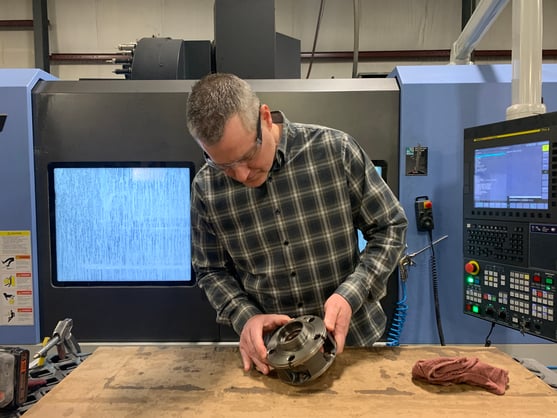In part 1 of our series on cost-effective, on-time CNC precision machining we explored how to go from RFQ to a successful project.
Today we’ll cover the ultimate measuring stick of every machining project: precision. Specifically, who contributes to — and is responsible for — the creation of a precision part.
RFQs drive precision
As a quick review, going through the RFQ process serves as the guide for the CNC machining shop, yet there are several key points within that process when precision is largely determined.
- When the engineering team digs in, comparing prints to models, to assist with programming and the designing of fixtures
- When the quality team creates control plans and CMM programs
- When shop advancements (usually in equipment and tooling) are made, which affect efficiency and/or accuracy
- When the shop reviews and confirms the current specs and frozen models, ensuring the latest documents are up to date
Revising an RFQ after the project is awarded is also a huge aspect of part precision. What requires major revisions? Are there any equipment upgrades? Have tooling costs changed? Should outside vendors confirm their pricing?
A successful part isn’t always a correct part
Just because a part has been machined the same way for 20 years doesn't mean it’s perfect. Print errors, for example, may not be discovered until they’re evaluated by an experienced engineer who knows a specified tolerance needs to be held.
The customer may not be expecting to hear that an additional qualifying operation is required to properly machine a 20-year-old part, but those conversations have to happen to ensure quality. Solid relationships make those discussions easier and not as uncomfortable, of course.
Here’s another example of a print error: An existing part needs to be machined under a tight timeline to meet production deadlines. The OEM reverse engineers the part, and it’s machined according to the specs, however an error in the print is uncovered after assembly.
Hopefully the parts can be quickly reworked by the machine shop and returned to the OEM without assembly delays, but a more costly outcome could be the result. The point is, mistakes happen that affect a part’s quality — especially complex parts — but aren’t caused by faulty machining. High-end CNC machine shops monitor processes as closely as they check precision.
Where does precision start?
There are complex parts, and then there are aerospace complex parts. And, no matter how much experience a CNC machine shop has, a part can’t be precisely machined without the right capabilities.
Proper evaluation and upfront examination ensure that a shop’s skills match the needs. An experienced engineering department goes a long way toward understanding how machining drives different tolerances, materials, and precision.
At the very beginning — during the RFQ stage — engineers should collaborate with the sales team to solidify not only a reliable quote but also a seamless transition into machining when awarded the work. The days of “get the PO and let engineering figure it out” are long gone.
A tech review fully explains the quote: what machines are to be used; how the part is to be held; what outside vendors are selected. While some tech reviews are more robust than others (picture concepts, FEMA, control plans, etc.), everything is in order and aligned to expectations.
Precision isn’t just about tight tolerances, it’s about pricing, too. After a project runs successfully, eventual revaluation may result in a cost reduction. Good CNC machine shops expect to improve efficiency as time goes on, so that process can be planned for upfront, too.
Proving precision to new customers
Anyone can purchase and set up a CNC machine, put an operator with 30 years of experience behind the spindle, and produce quality parts. This allows all CNC machines shops to claim ultimate precision, of course.
So, when many machine shops have similar capabilities, what can make one stand out? How can they show or explain how they’re not just different but superior?
A quality audit is the main way that customers, especially large OEMs, set themselves up for success. Step one is the shop completing quality reports sent from the OEM. Next, by physically visiting the CNC machine shop, scrutinizing their processes, reviewing their equipment, inspecting their parts, and meeting their people, the OEM gets a clearer vision of what a future partnership could look like.
If a shop “passes inspection,” the RFQ process likely begins. Fail the audit, and the shop is removed from the RFQ list altogether.
Checking certifications may seem obvious, but it’s often missed. Having an ISO 9001-compliant quality management system (QMS) and following IATF 16949 standards — perhaps along with ISO 9001:2015 — help ensure consistency and quality.
Precision is the name of the game, yet culture goes a long way, too. Employee attitude, collaboration, service and support, communication … they all reflect on quality assurance and directly correlate to precision.
No company is perfect, and problems do pop up. The key is turning those challenges into opportunities for success: showing innovative thinking, taking corrective action, expressing commitment to the project, and proving worth.
One more way to prove precision? Review that shop’s customer list. If it’s filled with large, well-respected, industry-leading companies, it shows a well-vetted supply chain, and it’s a good indication of high-quality work.
Similar to precision, culture can’t be faked. It’s built over time, and it’s the driving force of quality. See why at Stecker we say that “precision is the heart of high-quality machining,” (watch the video on this page).
Keep an eye out for our next blog: “CNC Machine Shops and the RFQ Process.”
Right now, enjoy some eye-opening mini-case studies that show Stecker’s willingness to dive into challenging CNC machining situations. Get your copy of In a Bind? 4 Projects During Which Stecker Machine Rescued Customers in Need by clicking the link below.







